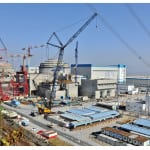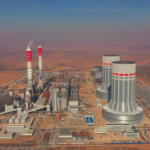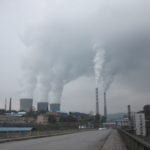Provinces across China are reportedly grappling with crippling power shortages prompted by a surge in power demand from a stunning ramp up in industrial activity, an especially harsh winter, and tight coal supplies, which may be exacerbated by a ban on Australian coal.
Power shortages have been reported in Zhejiang province, an economic powerhouse in eastern China; the southern provinces of Hunan and Jiangxi; as well as in Shaanxi province in the northwest and Guangdong province in the southeast.
In recent weeks, according to Reuters, more than a dozen Chinese cities in these provinces have imposed restrictions on power use, and some directives, such as in Wenzhou and Yiwu in Zhejiang province, are forcing factories to scale back production.
Some provinces are facing regional conditions, such as in Hunan, where wind turbines were frozen by a cold snap earlier this month. In Guangdong, a province that gets a quarter of its power from the massive Three Gorges Dam and nearly half from coal, equipment failures turned out the lights in industrial cities Dongguan, Shenzhen, Foshan, and Zhuhai, as well as Baiyun district in the provincial capital on Dec. 21. The South China Morning Post on Dec. 23 said the nationwide blackouts are “the worst in nearly a decade.”
The Post and other media outlets pin part of the problem to an extraordinary surge in power demand. Reuters reported that across China in November, power consumption rose 9% from a year earlier. The Post noted that from January to November, China consumed 6,677.2 billion kilowatt-hours (kWh) of electricity, more than the annual totals for 2017 and 2018. Industrial demand, notably, surged 10% in November, “fueled by a resurgent economy and a 21% increase in exports to meet COVID-driven demand for electronics, protective gear and other goods,” Reuters said.
However, the stunning post-COVID-19 economic recovery has reportedly been hampered by a shortage of thermal coal, especially from Australia, which is thought to make up a quarter of the nation’s thermal coal imports, according to Shanxi-based think tank China Coal Big Data Centre.
The Guardian on Dec. 24 reported that more than 50 Australian coal ships have been waiting offshore for more than four weeks, and at least three have been waiting since October, when China abruptly banned Australian coal amid a trade dispute that deepened after Canberra called for an investigation into the origin of the coronavirus. Australia’s Prime Minister Scott Morrison on Dec. 16 told The Morning Show, an Australian TV show, that while the Chinese government has not confirmed an official decision to ban Australian coal imports, “if there was such a ban on Australian coal, then that would be in direct contravention to the World Trade Organisation rules. It would also be a complete breach of the free trade agreement.”
The Post reported, citing “multiple sources in Chinese media,” that China is reluctant to link the power shortages to restrictions on Australian coal. State news agency Xinhua on Dec. 23 reported only that China’s benchmark power coal prices rose “slightly” during the past week. “Analysts said the supply and demand of coal in the Bohai-Rim area continued to be unbalanced in winter, a peak season for coal consumption. Weaker-than-expected supply from major coal producing areas and tight supply of imported coal have combined to lead to the price rise,” it said.
On Dec. 21, however, as Xinhua noted, China rolled out a strategy of “innovation-driven” development in the energy sector to address major issues and challenges, “such as energy resource constraints and climate change.”
The measure follows China’s President Xi Jinping headline-grabbing announcement on Sept. 22 that his country would strive to be carbon-neutral by 2060. The statement “potentially represents the biggest climate undertaking ever made by any country,” as International Energy Agency (IEA) Chief Economist Laszlo Varro and Senior Advisor An Fengguan wrote in an October commentary.
China, which is leading the world in nuclear additions, had installed 49 GW of nuclear capacity by 2019, but nuclear power’s share of generation made up a paltry 5%. According to the IEA, in 2019, China produced 65% of its total power (7,518 TWh) from coal, followed by renewables at 27%—mostly hydropower (17%), with wind (5%) and solar PV (3%) well behind. However, only about 53% of its total 1,991 GW installed capacity was coal-fired, while 40% was renewables.
The Chinese government’s Monday-released white paper, “Energy in China’s New Era,” describes goals to diversify its energy production infrastructure to include oil, natural gas, electricity, nuclear power, and renewable energy. But coal, which will remain “a basic energy source,” is a priority, the paper suggests. “Preliminary calculations show that China’s primary energy production in 2019 reached 3.97 billion tons of standard coal, making it the world’s largest energy producer,” it says.
Over the long-term, China will continue to strive to optimize coal-fired power and upgrade technology to steadily reduce excess capacity, the paper suggests. Already, “It has improved the early warning mechanism for risk control in coal-fired power planning and construction, and moved faster to phase out outdated capacity.” By the end of 2019, China had phased out more than 100 million kW of “outdated” coal power capacity, and the ratio of coal-fired power in total power generation had dropped from 65.7% in 2012 to 52% in 2019, it says.
Also highlighted in the paper are the nation’s “growing momentum” for energy conservation. So far, “China has tightened supervision of energy conservation over major national industrial projects, conducted diagnosis of industrial energy saving, and promoted industrial energy conservation and standardization of green manufacturing and growth,” it says. “China has taken action to manage the demand-side industrial power users, issued the ‘Guidelines for Power Demand-side Management in the Industrial Sector,’ and selected 153 industrial enterprises and parks as models. It is also cultivating energy service integrators in a bid to integrate modern energy services and industrial manufacturing.”
—Sonal Patel is a POWER senior associate editor (@sonalcpatel, @POWERmagazine).










